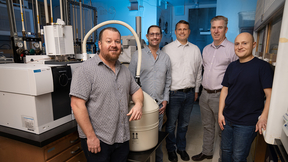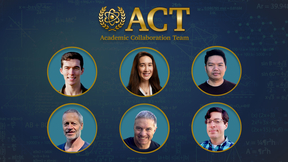Celebrating 25 years of high explosive research
This year, Lawrence Livermore National Laboratory's (LLNL) High Explosives Applications Facility (HEAF) celebrates a milestone - 25 years as a center of excellence for the research, development, synthesis, formulation and characterization of explosives.
The creation of HEAF stemmed from the recognition that the high explosives (HE) facilities at the Lab were old and scattered across LLNL, and that efficiency and productivity could be improved if all of the various disciplines and work areas could be housed in a single facility dedicated to HE research and development. Construction was completed in 1988 and the facility was fully operational by 1989. Today, HEAF remains the only facility of its kind in the world.
"Since the Laboratory's inception in 1952, Livermore researchers have lead the nation in understanding, synthesizing, formulating, testing and modeling the chemical high explosives that are an integral part of every nuclear weapon system," LLNL Energetic Materials Center Director Jon Maienschein said. "At HEAF, these researchers are all housed under one roof, strengthening collaborations and integrating all of the disparate high-explosives activity."
This physical integration fosters collaboration among diverse sets of disciplines that interact infrequently in traditional, geographically dispersed HE research and development environments. This unique opportunity for collaboration has made the scientists and engineers in HEAF subject matter experts for high explosives and other energetic materials. Furthermore, the facility enables LLNL to be a leader in many areas of national security, including weapon development, homeland security and counterterrorism. Examples include:
- Stockpile stewardship, assuring the reliability and safety of the nation's nuclear weapons
- Conventional weapon development, including special-purpose weapons, armor penetration and infantry protective equipment design
- Development of new safer explosives for military and commercial use
- Counterterrorism, including improvised explosives
- Basic explosives research and development
- Development of next-generation high-speed diagnostics for explosives research
At HEAF, all of the facilities needed to undertake these diverse activities are found under one roof. Chemistry laboratories exist for the synthesis, formulation, characterization, and testing of high explosives and other energetic materials. The firing operations area of HEAF includes seven fully-contained firing vessels, with explosive capacities ranging from gram quantities up to 10 kilograms net explosive weight. These firing tanks are equipped with a variety of diagnostics to provide abundant dynamic data return. The combination of cutting-edge computational analysis and highly diagnosed experiments allows for rapid and efficient advances in energetic material research.
Happy birthday, HEAF
At a celebration Wednesday, a large group of current and former HEAF residents and Laboratory leadership gathered to honor the facility and its personnel.
"This is clearly a unique facility in the complex and a unique facility in the Laboratory, both in the past and into the future," said Charlie Verdon, principal associate director for Weapons and Complex Integration (WCI). "We thought it important to recognize the role this facility has played and will continue to play."
The audience then received a historical perspective from Randy Simpson, WCI's US/UK program leader.
"Visionaries are people who see what's missing, and then they make dreams come true," he said. "HEAF is an example of one man's vision."
This visionary was Dick Weingart, who served as the program leader for Defense Systems High-Explosives and is considered by many to be HEAF's "founding father." He was involved in the creation of HEAF in all aspects and recognized something that many people hadn't - that a tight interdisciplinary coupling was necessary. This interdisciplinary vision matched that of LLNL founder E. O. Lawrence, whose philosophy of putting large multi-disciplinary teams together to tackle grand scientific challenges was a grounding principle for the Laboratory.
"It was audacious for its day, bringing together all of these disciplines into one facility and one group," Simpson said. "When you are thinking about all of the things that the Laboratory has accomplished because of HEAF, take a minute to remember Dick Weingart. This was one individual that had a vision and a passion."
In 1984, Weingart predicted HEAF's future when he said "HEAF will be the most sophisticated high-explosives research facility in the free world." When the facility was completed four years later, he was proven right, and this continues to be true today as the facility evolves and adds new capabilities and skill sets.
Maienschein then spoke to the crowd about HEAF's many accomplishments over the last 25 years in the areas of stockpile stewardship, advanced modeling and simulation, diagnostics, new energetic materials, support of the energetic material community and operational excellence. Read more about these accomplishments.
The focus turned to the future as LLNL Director Bill Goldstein spoke to the crowd.
"Thinking about the future of the Laboratory, the capabilities represented here and the role HEAF has in the high explosives community are part of the foundation on which the Laboratory is going to build its future," he said. "This work is going to continue to have a critical and important role, especially as work continues on the safety and security of the stockpile."
Contact
 Breanna Bishop
Breanna Bishop
[email protected]
(925) 423-9802
Related Links
High Explosives Application FacilityHEAF adds a major new capability
Energetic Materials Center is advancing scientific understanding of high explosives
Related Files
DownloadTags
Strategic DeterrenceHEAF
Science
Featured Articles









